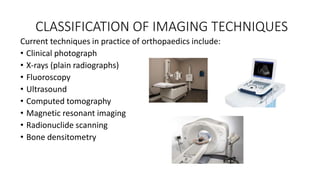This document provides an overview of various imaging techniques used in orthopaedics, including their history, uses, and classifications. It discusses techniques such as x-rays, CT, MRI, ultrasound, bone scans, and DEXA scans. For each technique, it covers the basic principles, advantages, disadvantages, and applications in orthopaedics such as diagnosis, surgical planning, and monitoring treatment.












































